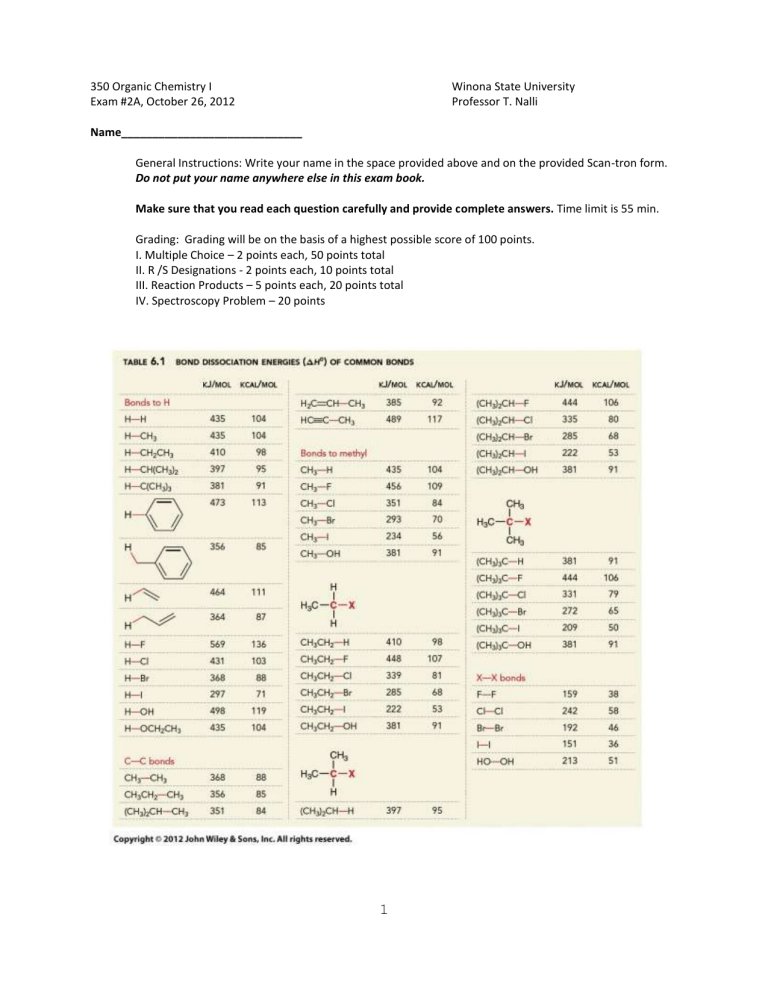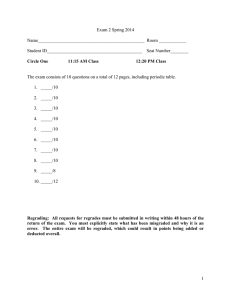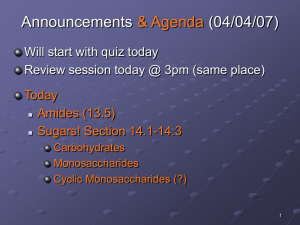Exam 2 - Winona State University

350 Organic Chemistry I
Exam #2A, October 26, 2012
Winona State University
Professor T. Nalli
Name_____________________________
General Instructions: Write your name in the space provided above and on the provided Scan-tron form.
Do not put your name anywhere else in this exam book.
Make sure that you read each question carefully and provide complete answers. Time limit is 55 min.
II. R /S Designations - 2 points each, 10 points total
III. Reaction Products – 5 points each, 20 points total
IV. Spectroscopy Problem – 20 points
Grading: Grading will be on the basis of a highest possible score of 100 points.
I. Multiple Choice – 2 points each, 50 points total
1
11.
12.
1.
2.
I. Multiple Choice
I. Each of the following multiple choice questions has one and only one correct response. Mark the letter of the correct response to each question on the Scan-Tron form provided. A #2 pencil should be used. (Make sure to write your name on the Scan-Tron form.)
Use the following choices for questions 1-3.
A.
B.
C.
D.
E.
Which is the least stable carbocation?
Which is the most stable?
Which carbocation is expected to undergo a 1,2-hydride shift? 3.
4. Which of these correctly describes the overall reaction a e? (See Figure 1)
A. non-concerted, exothermic
B. non-concerted, endothermic
C. concerted, exothermic
D. concerted, endothermic
5.
6.
Which of the following reactions is the fastest? (See Figure 1)
A. a c B. c e C. c a D. e c
What points on the graph represent transition states? (See Figure 1)
A. c only B. b and d C. b, c, and d D. c and e
Figure 1 - PE Diagram for
Questions 4-6
7. Use the table of BDEs on the front page to predict the ΔH of the following hypothetical reaction.
CH
3
CH
2
Br + H
2
O CH
3
CH
2
OH + HBr
A.
+8 kcal/mol B. −8 kcal/mol C. +5 kcal/mol D. −5 kcal/mol
8. Under what conditions does the entropy change of a reaction (ΔS) become important enough so that the approximation
ΔG ≈ ΔH no longer holds?
A. high concentration B. low concentration C. low temperature D. high temperature
9. A 20.0 g sample of a compound having a molecular weight of 200.0 g/mol was dissolved in enough dichloromethane to give 20.0 mL of solution. This solution, when placed in a 2-dm polarimeter tube, gave an observed rotation of +5.0
.
What is the specific rotation of the compound?
A. +0.50
B. +1.0
C. +0.25
D. +2.5
10. The ee% of a research compound was found by NMR to be 50%. Which of these statements correctly describes the compound?
A. It is a mixture of enantiomers in a 4:1 ratio
B. It is a mixture of enantiomers in a 3:1 ratio
C. It is a mixture of diastereomers in a 4:1 ratio
D. It is a mixture of diastereomers in a 3:1 ratio.
E. It is a racemic mixture
Which of the following can exist as a meso compound?
A. 1,1-dimethylcyclohexane B. 1,2-dimethylcyclohexane C. 1,4-dimethylcyclohexane D. ethylcyclohexane
Which of the following alkenes is chiral?
A.
B.
C.
D.
E.
2
OH
13. The molecule shown at right can exist as any one of how many different stereoisomers?
A. 4 B. 6 C. 8 D. 2 E. stereoisomerism is not possible for this molecule
For Questions 14-17 identify the relationship between the two structures shown. Use the following choices:
A. enantiomers B. diastereomers C. constitutional isomers D. same compound
14.
CH
3
CH
2
OH
15. CH
3
F
H F H F
H F H
CH
2
OH CH
3 CH
2
OH CH
3
CH
2
OH
F F
F F
16.
18.
HO
OH HO
OH
17.
Rank the indicated bonds in decreasing (highest to lowest) order of frequency of IR absorption.
A. I > II > III
B. III > II > I
C. II > I > III
D. III > I > II
I
H H II
H
19. Which of the following compounds will show IR peaks at both 3300 cm -1 and 1650 cm -1 ?
OH O
OH
O
A.
B.
CH
3
C.
NC D.
20. What are the expected peak multiplicities in the 1
O
A. q, t, t, m, s B. s, t, t, d, m C. t, q, m, t, d D. t, q, d, m, d
21. What are the expected peak multiplicities in the 1
O
A. t, m, t B. q, t, t C. s, s, s D. d, d, q
III
22. What is the effect of doubling both the nucleophile and the RX concentrations on the rate of an S
N
1 reaction?
A. no effect B. the rate doubles C. the rate is cut in half D. the rate quadruples
23. Which of these is the best solvent to use if a product with a high ee% is desired from an S
N
reaction of an enantiomerically-pure secondary alkyl halide?
A. CH
3
CN B. CH
3
OH C. CH
3
CO
2
H D. CH
3
CH
2
NH
2
24. What is the structure of DMSO?
A.
S B.
25.
Si
C.
O
S
Which of the following substrates gives the fastest S
N
2 reactions?
D.
S
E.
S C S
A.
Br
B.
Cl
C.
Br
D.
Cl
E.
F
3
1.
II. Label each of the following as R or S as appropriate. (You will need to show priorities of all groups for any partial credit.)
O
O
OH
O
OH
CH
2
CN
H NH
SH
2
CH
3
H NH
OH
2
IV. (a) Predict the product of each of the following nucleophilic substitution reactions. If no reaction is expected to occur then write N.R. and explain your reasoning. (b) Write out the mechanism for ach reaction using curved arrows to show electron flow. (If you need more room to show a mechanism then please use the back of the previous page.)
OTs
NaI acetone
2.
OH
NaSH
CH
3
CN
CH
3
OH
3.
Br
4.
I
KCN
DMSO
4
IV. A compound with molecular formula C
6
H
12
O displays the following IR and 1 H NMR spectra. Propose a structure for this compound. Explain your reasoning by labeling all key peaks in the spectra.
1
5








